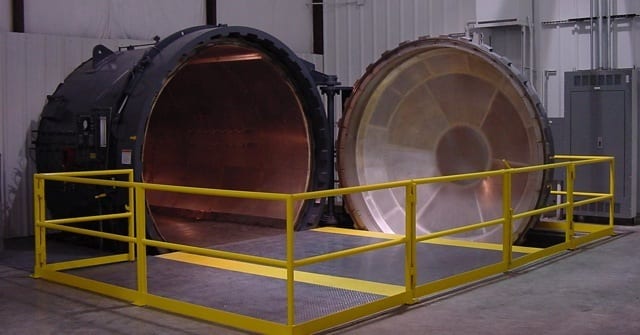OSHKOSH — During an opening day news conference at AirVenture, officials from Cirrus Aircraft reported that the Vision SF50 personal jet program has made significant progress toward certification, including acquisition of manufacturing equipment to build the new airplane. The company confirms that first delivery is still scheduled for late 2015.
The next steps in the Vision SF50 jet program involve building conforming aircraft for further certification testing and preparing the Cirrus headquarters in Duluth and its manufacturing facility in Grand Forks, N.D., for production, officials said.
“This is an exciting time for the Cirrus Vision,” said Dale Klapmeier, CEO and co-founder of Cirrus Aircraft. “The program continues to progress forward on schedule as we move into building our conforming aircraft. We are taking delivery of some outstanding equipment that will enable us to move into the production phase of the certification process.”
The first verification vehicle, V1, which first flew in July 2008, has been fulfilling its purpose to verify the design of the aircraft and answer specific questions about performance and design to inform building of conforming vehicles, he said. The data generated from V1 was used to finalize the aerodynamic shape (Type Design or TD) and the configuration was frozen in 2010.
Milestones the V1 has met since last year include:
- Pitot and Static sensor location
- Stall speed and Flap refinement
- FADEC to Avionics integration
- Continued natural icing testing
- Training familiarization and marketing demonstration flights
- Trim Optimization
In 2014, Cirrus will introduce the next flight test vehicle, the company’s first conforming jet (C0). At this point, the aircraft is built and inspected to production drawings and built on production tooling using production processes.
The primary use of the C0 will be performance verification, flying qualities certification and production tooling and process development. The next assembled flight article will be C1. It will be used mainly for aircraft systems development and certification plus refinement of production components and assembly planning.
The final flying article will be C2. This aircraft will enter the flight test program in the latter stages of certification and will reflect, as close as possible, the first production configuration aircraft in both equipment and manufacturing processes.
An integral part of building C0 includes building the production tools and preparing the company’s facilities for ultimate production of the Vision jets. Two developments in production preparation include the acquisition of the robotic trim and drill facility at Cirrus’ headquarters in Duluth and the installation of a fuselage lay-up mold in the Grand Forks, N.D. facility.
 One of the first requirements in C0 is installation of production tooling that will be used to build production model jets for delivery. Tooling installation is well underway, and Cirrus recently took delivery of the robotic trim and drill facility. This 6-axis robot arm has a 10-foot reach, 40-foot rail (7th axis) and a lifting capacity of 180 pounds. It is fully enclosed with an automatic dust collection system and has a 40-tool automated tool changer. A laser depth instrument and camera/vision system aligns parts while a vacuum table holds them in place during cutting. Its primary use is for trimming and drilling composite parts. It may also be used for indicating bond/inspection zones on parts and for milling master patterns for molds. It controls feed rates, penetration rates and spindle speeds to produce high quality holes and is accurate to thousandths of an inch over the entire envelope.
One of the first requirements in C0 is installation of production tooling that will be used to build production model jets for delivery. Tooling installation is well underway, and Cirrus recently took delivery of the robotic trim and drill facility. This 6-axis robot arm has a 10-foot reach, 40-foot rail (7th axis) and a lifting capacity of 180 pounds. It is fully enclosed with an automatic dust collection system and has a 40-tool automated tool changer. A laser depth instrument and camera/vision system aligns parts while a vacuum table holds them in place during cutting. Its primary use is for trimming and drilling composite parts. It may also be used for indicating bond/inspection zones on parts and for milling master patterns for molds. It controls feed rates, penetration rates and spindle speeds to produce high quality holes and is accurate to thousandths of an inch over the entire envelope.
“This trim and drill robot will give Cirrus unprecedented capability in accuracy, speed and component-to-component fit compared to the industry standard template and fixture methods,” stated President and CEO Pat Waddick. “It is very flexible to accommodate design changes and eliminates the need to design and build hundreds of manual trim and drill fixtures.”
The first of nine total fuselage bond fixtures was installed at the Grand Forks facility. The 28-foot long, 6-ton fixture will be used beginning this month. The tool’s autoclave oven also arrived.
 An autoclave oven is used in the manufacturing process of composite parts – in this case very large parts, such as the carbon fiber main spar of the Vision SF50 jet.
An autoclave oven is used in the manufacturing process of composite parts – in this case very large parts, such as the carbon fiber main spar of the Vision SF50 jet.
When all tooling is complete, the Vision SF50 fuselage production process will have:
- 5 major bond fixtures
- 4 smaller bond fixtures
- 163 layup molds
- 75 other small tools
- 1 robotic trim and drill facility
For more information: CirrusAircraft.com.

Darn, why was I born too soon to see this and have one of these? But I was able to own a C-140 and a BE-35 and I thank the good Lord for that blessing that is far better than most.
GO Cirrus.